Communication Development, Transitions and Disorders Analysis Report
VerifiedAdded on 2023/01/13
|13
|4267
|89
Report
AI Summary
This report provides an in-depth analysis of communication development in children from 0 to 19 years old. It emphasizes the significance of early identification of language, speech, and communication disorders, highlighting the impact of delays on a child's development and the importance of early intervention services. The report examines the collaborative efforts of multi-agency teams in supporting children with communication needs, detailing their roles and strategies. It also explores the various transitions children experience, from infancy to adolescence, and demonstrates how these transitions influence their behavior and development, including a specific focus on bereavement. The report further discusses the role of play and activities in speech, language, and communication development, as well as the work of communication development theorists.

Communication
development
development
Paraphrase This Document
Need a fresh take? Get an instant paraphrase of this document with our AI Paraphraser
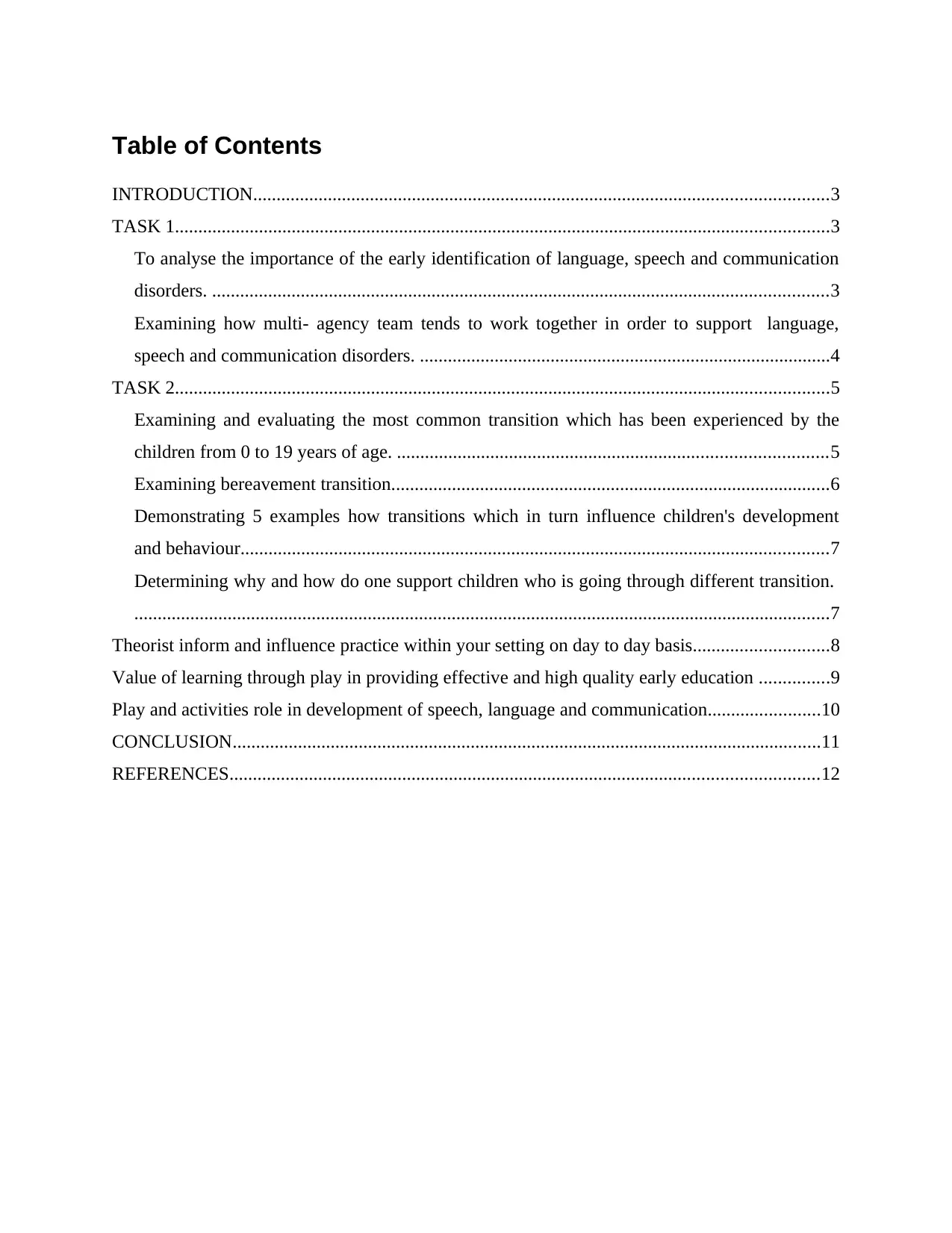
Table of Contents
INTRODUCTION...........................................................................................................................3
TASK 1............................................................................................................................................3
To analyse the importance of the early identification of language, speech and communication
disorders. ....................................................................................................................................3
Examining how multi- agency team tends to work together in order to support language,
speech and communication disorders. ........................................................................................4
TASK 2............................................................................................................................................5
Examining and evaluating the most common transition which has been experienced by the
children from 0 to 19 years of age. ............................................................................................5
Examining bereavement transition..............................................................................................6
Demonstrating 5 examples how transitions which in turn influence children's development
and behaviour..............................................................................................................................7
Determining why and how do one support children who is going through different transition.
.....................................................................................................................................................7
Theorist inform and influence practice within your setting on day to day basis.............................8
Value of learning through play in providing effective and high quality early education ...............9
Play and activities role in development of speech, language and communication........................10
CONCLUSION..............................................................................................................................11
REFERENCES..............................................................................................................................12
INTRODUCTION...........................................................................................................................3
TASK 1............................................................................................................................................3
To analyse the importance of the early identification of language, speech and communication
disorders. ....................................................................................................................................3
Examining how multi- agency team tends to work together in order to support language,
speech and communication disorders. ........................................................................................4
TASK 2............................................................................................................................................5
Examining and evaluating the most common transition which has been experienced by the
children from 0 to 19 years of age. ............................................................................................5
Examining bereavement transition..............................................................................................6
Demonstrating 5 examples how transitions which in turn influence children's development
and behaviour..............................................................................................................................7
Determining why and how do one support children who is going through different transition.
.....................................................................................................................................................7
Theorist inform and influence practice within your setting on day to day basis.............................8
Value of learning through play in providing effective and high quality early education ...............9
Play and activities role in development of speech, language and communication........................10
CONCLUSION..............................................................................................................................11
REFERENCES..............................................................................................................................12
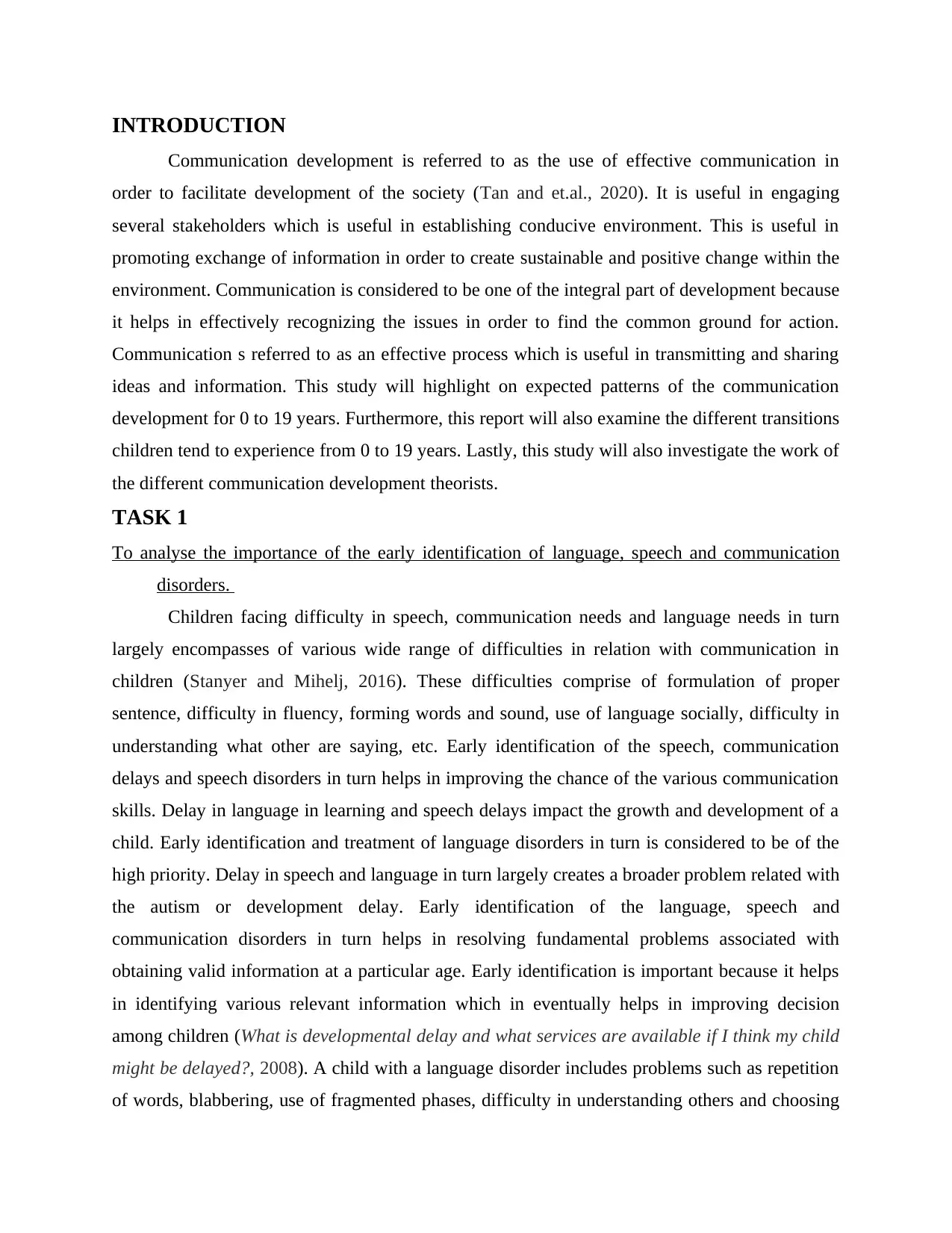
INTRODUCTION
Communication development is referred to as the use of effective communication in
order to facilitate development of the society (Tan and et.al., 2020). It is useful in engaging
several stakeholders which is useful in establishing conducive environment. This is useful in
promoting exchange of information in order to create sustainable and positive change within the
environment. Communication is considered to be one of the integral part of development because
it helps in effectively recognizing the issues in order to find the common ground for action.
Communication s referred to as an effective process which is useful in transmitting and sharing
ideas and information. This study will highlight on expected patterns of the communication
development for 0 to 19 years. Furthermore, this report will also examine the different transitions
children tend to experience from 0 to 19 years. Lastly, this study will also investigate the work of
the different communication development theorists.
TASK 1
To analyse the importance of the early identification of language, speech and communication
disorders.
Children facing difficulty in speech, communication needs and language needs in turn
largely encompasses of various wide range of difficulties in relation with communication in
children (Stanyer and Mihelj, 2016). These difficulties comprise of formulation of proper
sentence, difficulty in fluency, forming words and sound, use of language socially, difficulty in
understanding what other are saying, etc. Early identification of the speech, communication
delays and speech disorders in turn helps in improving the chance of the various communication
skills. Delay in language in learning and speech delays impact the growth and development of a
child. Early identification and treatment of language disorders in turn is considered to be of the
high priority. Delay in speech and language in turn largely creates a broader problem related with
the autism or development delay. Early identification of the language, speech and
communication disorders in turn helps in resolving fundamental problems associated with
obtaining valid information at a particular age. Early identification is important because it helps
in identifying various relevant information which in eventually helps in improving decision
among children (What is developmental delay and what services are available if I think my child
might be delayed?, 2008). A child with a language disorder includes problems such as repetition
of words, blabbering, use of fragmented phases, difficulty in understanding others and choosing
Communication development is referred to as the use of effective communication in
order to facilitate development of the society (Tan and et.al., 2020). It is useful in engaging
several stakeholders which is useful in establishing conducive environment. This is useful in
promoting exchange of information in order to create sustainable and positive change within the
environment. Communication is considered to be one of the integral part of development because
it helps in effectively recognizing the issues in order to find the common ground for action.
Communication s referred to as an effective process which is useful in transmitting and sharing
ideas and information. This study will highlight on expected patterns of the communication
development for 0 to 19 years. Furthermore, this report will also examine the different transitions
children tend to experience from 0 to 19 years. Lastly, this study will also investigate the work of
the different communication development theorists.
TASK 1
To analyse the importance of the early identification of language, speech and communication
disorders.
Children facing difficulty in speech, communication needs and language needs in turn
largely encompasses of various wide range of difficulties in relation with communication in
children (Stanyer and Mihelj, 2016). These difficulties comprise of formulation of proper
sentence, difficulty in fluency, forming words and sound, use of language socially, difficulty in
understanding what other are saying, etc. Early identification of the speech, communication
delays and speech disorders in turn helps in improving the chance of the various communication
skills. Delay in language in learning and speech delays impact the growth and development of a
child. Early identification and treatment of language disorders in turn is considered to be of the
high priority. Delay in speech and language in turn largely creates a broader problem related with
the autism or development delay. Early identification of the language, speech and
communication disorders in turn helps in resolving fundamental problems associated with
obtaining valid information at a particular age. Early identification is important because it helps
in identifying various relevant information which in eventually helps in improving decision
among children (What is developmental delay and what services are available if I think my child
might be delayed?, 2008). A child with a language disorder includes problems such as repetition
of words, blabbering, use of fragmented phases, difficulty in understanding others and choosing
⊘ This is a preview!⊘
Do you want full access?
Subscribe today to unlock all pages.

Trusted by 1+ million students worldwide
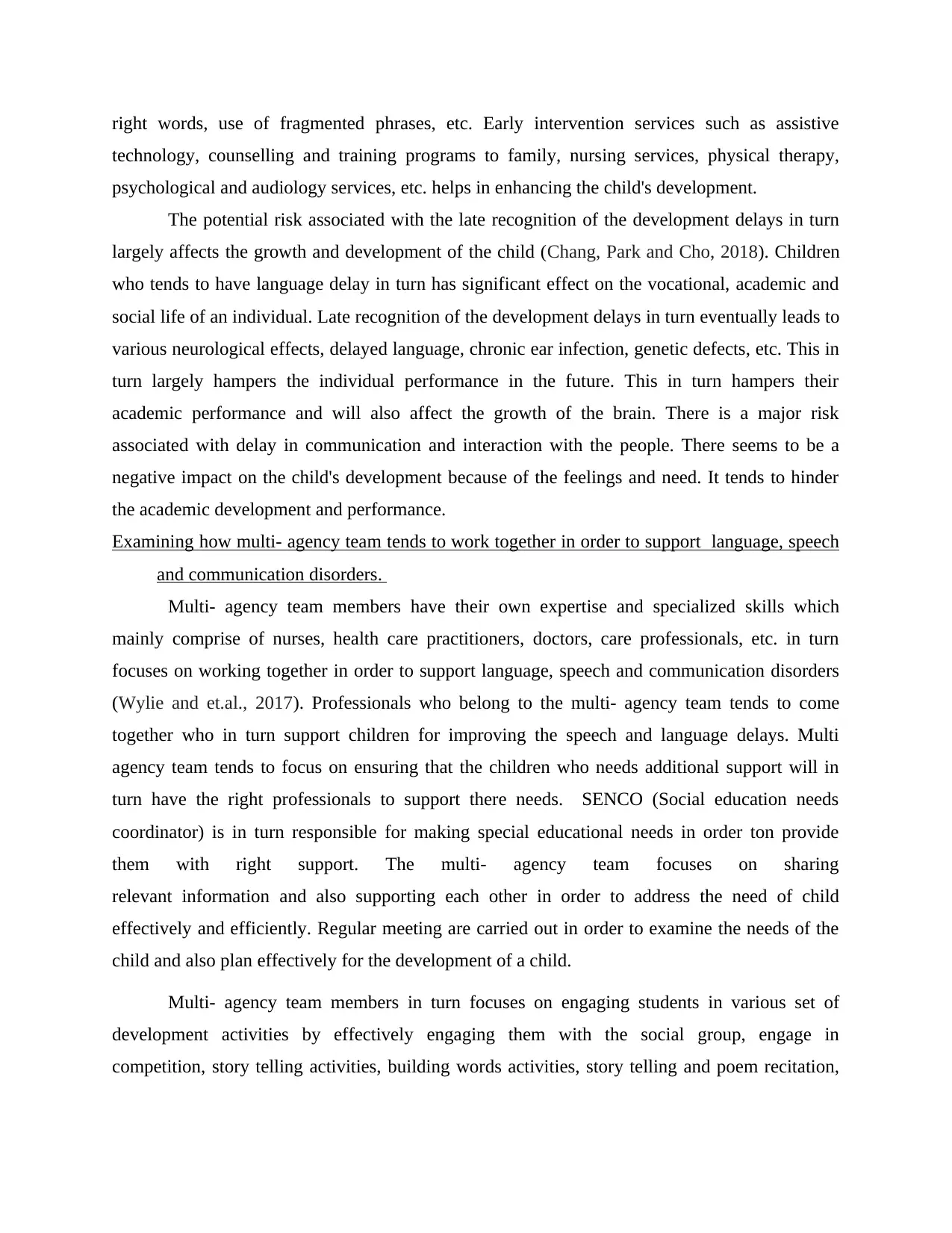
right words, use of fragmented phrases, etc. Early intervention services such as assistive
technology, counselling and training programs to family, nursing services, physical therapy,
psychological and audiology services, etc. helps in enhancing the child's development.
The potential risk associated with the late recognition of the development delays in turn
largely affects the growth and development of the child (Chang, Park and Cho, 2018). Children
who tends to have language delay in turn has significant effect on the vocational, academic and
social life of an individual. Late recognition of the development delays in turn eventually leads to
various neurological effects, delayed language, chronic ear infection, genetic defects, etc. This in
turn largely hampers the individual performance in the future. This in turn hampers their
academic performance and will also affect the growth of the brain. There is a major risk
associated with delay in communication and interaction with the people. There seems to be a
negative impact on the child's development because of the feelings and need. It tends to hinder
the academic development and performance.
Examining how multi- agency team tends to work together in order to support language, speech
and communication disorders.
Multi- agency team members have their own expertise and specialized skills which
mainly comprise of nurses, health care practitioners, doctors, care professionals, etc. in turn
focuses on working together in order to support language, speech and communication disorders
(Wylie and et.al., 2017). Professionals who belong to the multi- agency team tends to come
together who in turn support children for improving the speech and language delays. Multi
agency team tends to focus on ensuring that the children who needs additional support will in
turn have the right professionals to support there needs. SENCO (Social education needs
coordinator) is in turn responsible for making special educational needs in order ton provide
them with right support. The multi- agency team focuses on sharing
relevant information and also supporting each other in order to address the need of child
effectively and efficiently. Regular meeting are carried out in order to examine the needs of the
child and also plan effectively for the development of a child.
Multi- agency team members in turn focuses on engaging students in various set of
development activities by effectively engaging them with the social group, engage in
competition, story telling activities, building words activities, story telling and poem recitation,
technology, counselling and training programs to family, nursing services, physical therapy,
psychological and audiology services, etc. helps in enhancing the child's development.
The potential risk associated with the late recognition of the development delays in turn
largely affects the growth and development of the child (Chang, Park and Cho, 2018). Children
who tends to have language delay in turn has significant effect on the vocational, academic and
social life of an individual. Late recognition of the development delays in turn eventually leads to
various neurological effects, delayed language, chronic ear infection, genetic defects, etc. This in
turn largely hampers the individual performance in the future. This in turn hampers their
academic performance and will also affect the growth of the brain. There is a major risk
associated with delay in communication and interaction with the people. There seems to be a
negative impact on the child's development because of the feelings and need. It tends to hinder
the academic development and performance.
Examining how multi- agency team tends to work together in order to support language, speech
and communication disorders.
Multi- agency team members have their own expertise and specialized skills which
mainly comprise of nurses, health care practitioners, doctors, care professionals, etc. in turn
focuses on working together in order to support language, speech and communication disorders
(Wylie and et.al., 2017). Professionals who belong to the multi- agency team tends to come
together who in turn support children for improving the speech and language delays. Multi
agency team tends to focus on ensuring that the children who needs additional support will in
turn have the right professionals to support there needs. SENCO (Social education needs
coordinator) is in turn responsible for making special educational needs in order ton provide
them with right support. The multi- agency team focuses on sharing
relevant information and also supporting each other in order to address the need of child
effectively and efficiently. Regular meeting are carried out in order to examine the needs of the
child and also plan effectively for the development of a child.
Multi- agency team members in turn focuses on engaging students in various set of
development activities by effectively engaging them with the social group, engage in
competition, story telling activities, building words activities, story telling and poem recitation,
Paraphrase This Document
Need a fresh take? Get an instant paraphrase of this document with our AI Paraphraser
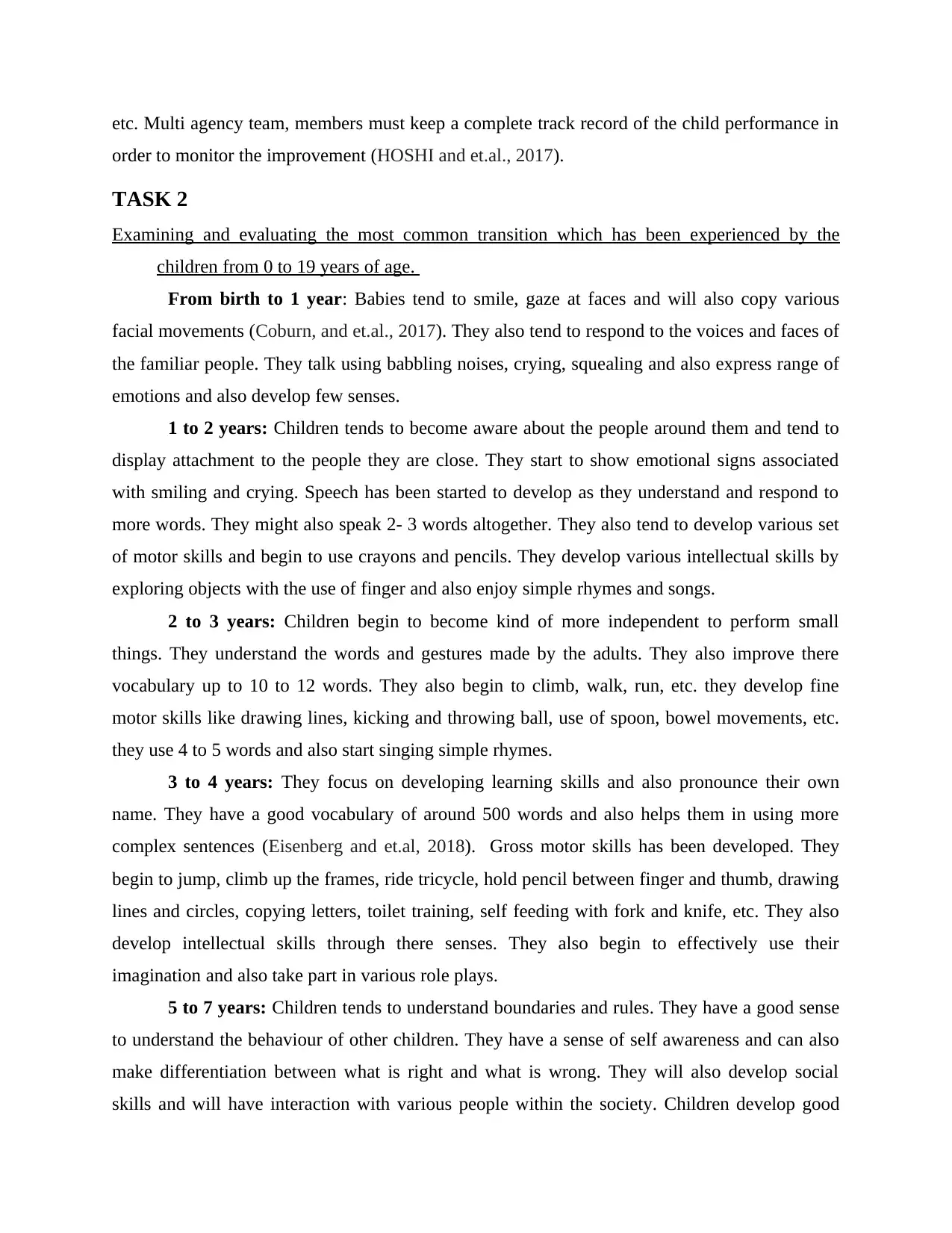
etc. Multi agency team, members must keep a complete track record of the child performance in
order to monitor the improvement (HOSHI and et.al., 2017).
TASK 2
Examining and evaluating the most common transition which has been experienced by the
children from 0 to 19 years of age.
From birth to 1 year: Babies tend to smile, gaze at faces and will also copy various
facial movements (Coburn, and et.al., 2017). They also tend to respond to the voices and faces of
the familiar people. They talk using babbling noises, crying, squealing and also express range of
emotions and also develop few senses.
1 to 2 years: Children tends to become aware about the people around them and tend to
display attachment to the people they are close. They start to show emotional signs associated
with smiling and crying. Speech has been started to develop as they understand and respond to
more words. They might also speak 2- 3 words altogether. They also tend to develop various set
of motor skills and begin to use crayons and pencils. They develop various intellectual skills by
exploring objects with the use of finger and also enjoy simple rhymes and songs.
2 to 3 years: Children begin to become kind of more independent to perform small
things. They understand the words and gestures made by the adults. They also improve there
vocabulary up to 10 to 12 words. They also begin to climb, walk, run, etc. they develop fine
motor skills like drawing lines, kicking and throwing ball, use of spoon, bowel movements, etc.
they use 4 to 5 words and also start singing simple rhymes.
3 to 4 years: They focus on developing learning skills and also pronounce their own
name. They have a good vocabulary of around 500 words and also helps them in using more
complex sentences (Eisenberg and et.al, 2018). Gross motor skills has been developed. They
begin to jump, climb up the frames, ride tricycle, hold pencil between finger and thumb, drawing
lines and circles, copying letters, toilet training, self feeding with fork and knife, etc. They also
develop intellectual skills through there senses. They also begin to effectively use their
imagination and also take part in various role plays.
5 to 7 years: Children tends to understand boundaries and rules. They have a good sense
to understand the behaviour of other children. They have a sense of self awareness and can also
make differentiation between what is right and what is wrong. They will also develop social
skills and will have interaction with various people within the society. Children develop good
order to monitor the improvement (HOSHI and et.al., 2017).
TASK 2
Examining and evaluating the most common transition which has been experienced by the
children from 0 to 19 years of age.
From birth to 1 year: Babies tend to smile, gaze at faces and will also copy various
facial movements (Coburn, and et.al., 2017). They also tend to respond to the voices and faces of
the familiar people. They talk using babbling noises, crying, squealing and also express range of
emotions and also develop few senses.
1 to 2 years: Children tends to become aware about the people around them and tend to
display attachment to the people they are close. They start to show emotional signs associated
with smiling and crying. Speech has been started to develop as they understand and respond to
more words. They might also speak 2- 3 words altogether. They also tend to develop various set
of motor skills and begin to use crayons and pencils. They develop various intellectual skills by
exploring objects with the use of finger and also enjoy simple rhymes and songs.
2 to 3 years: Children begin to become kind of more independent to perform small
things. They understand the words and gestures made by the adults. They also improve there
vocabulary up to 10 to 12 words. They also begin to climb, walk, run, etc. they develop fine
motor skills like drawing lines, kicking and throwing ball, use of spoon, bowel movements, etc.
they use 4 to 5 words and also start singing simple rhymes.
3 to 4 years: They focus on developing learning skills and also pronounce their own
name. They have a good vocabulary of around 500 words and also helps them in using more
complex sentences (Eisenberg and et.al, 2018). Gross motor skills has been developed. They
begin to jump, climb up the frames, ride tricycle, hold pencil between finger and thumb, drawing
lines and circles, copying letters, toilet training, self feeding with fork and knife, etc. They also
develop intellectual skills through there senses. They also begin to effectively use their
imagination and also take part in various role plays.
5 to 7 years: Children tends to understand boundaries and rules. They have a good sense
to understand the behaviour of other children. They have a sense of self awareness and can also
make differentiation between what is right and what is wrong. They will also develop social
skills and will have interaction with various people within the society. Children develop good
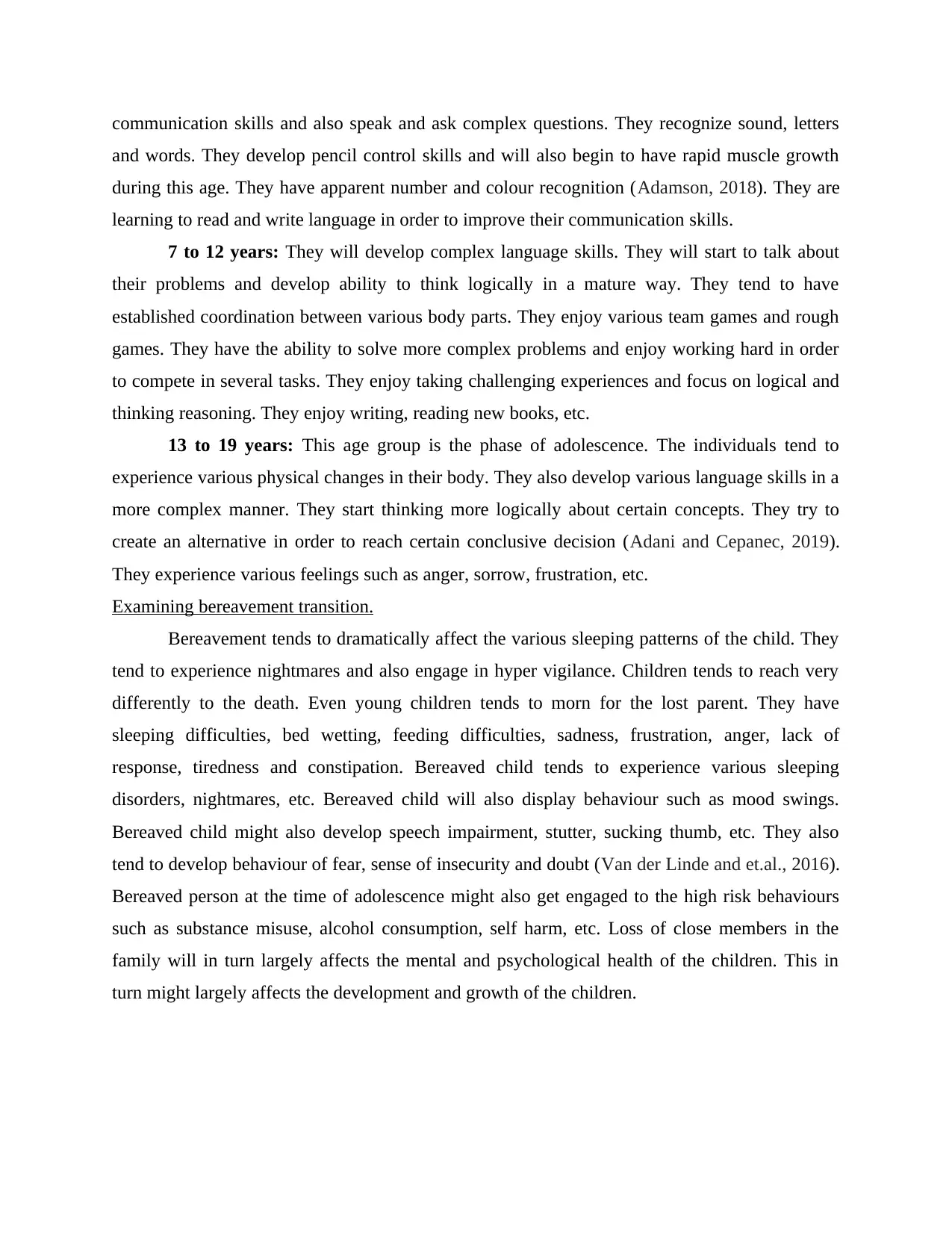
communication skills and also speak and ask complex questions. They recognize sound, letters
and words. They develop pencil control skills and will also begin to have rapid muscle growth
during this age. They have apparent number and colour recognition (Adamson, 2018). They are
learning to read and write language in order to improve their communication skills.
7 to 12 years: They will develop complex language skills. They will start to talk about
their problems and develop ability to think logically in a mature way. They tend to have
established coordination between various body parts. They enjoy various team games and rough
games. They have the ability to solve more complex problems and enjoy working hard in order
to compete in several tasks. They enjoy taking challenging experiences and focus on logical and
thinking reasoning. They enjoy writing, reading new books, etc.
13 to 19 years: This age group is the phase of adolescence. The individuals tend to
experience various physical changes in their body. They also develop various language skills in a
more complex manner. They start thinking more logically about certain concepts. They try to
create an alternative in order to reach certain conclusive decision (Adani and Cepanec, 2019).
They experience various feelings such as anger, sorrow, frustration, etc.
Examining bereavement transition.
Bereavement tends to dramatically affect the various sleeping patterns of the child. They
tend to experience nightmares and also engage in hyper vigilance. Children tends to reach very
differently to the death. Even young children tends to morn for the lost parent. They have
sleeping difficulties, bed wetting, feeding difficulties, sadness, frustration, anger, lack of
response, tiredness and constipation. Bereaved child tends to experience various sleeping
disorders, nightmares, etc. Bereaved child will also display behaviour such as mood swings.
Bereaved child might also develop speech impairment, stutter, sucking thumb, etc. They also
tend to develop behaviour of fear, sense of insecurity and doubt (Van der Linde and et.al., 2016).
Bereaved person at the time of adolescence might also get engaged to the high risk behaviours
such as substance misuse, alcohol consumption, self harm, etc. Loss of close members in the
family will in turn largely affects the mental and psychological health of the children. This in
turn might largely affects the development and growth of the children.
and words. They develop pencil control skills and will also begin to have rapid muscle growth
during this age. They have apparent number and colour recognition (Adamson, 2018). They are
learning to read and write language in order to improve their communication skills.
7 to 12 years: They will develop complex language skills. They will start to talk about
their problems and develop ability to think logically in a mature way. They tend to have
established coordination between various body parts. They enjoy various team games and rough
games. They have the ability to solve more complex problems and enjoy working hard in order
to compete in several tasks. They enjoy taking challenging experiences and focus on logical and
thinking reasoning. They enjoy writing, reading new books, etc.
13 to 19 years: This age group is the phase of adolescence. The individuals tend to
experience various physical changes in their body. They also develop various language skills in a
more complex manner. They start thinking more logically about certain concepts. They try to
create an alternative in order to reach certain conclusive decision (Adani and Cepanec, 2019).
They experience various feelings such as anger, sorrow, frustration, etc.
Examining bereavement transition.
Bereavement tends to dramatically affect the various sleeping patterns of the child. They
tend to experience nightmares and also engage in hyper vigilance. Children tends to reach very
differently to the death. Even young children tends to morn for the lost parent. They have
sleeping difficulties, bed wetting, feeding difficulties, sadness, frustration, anger, lack of
response, tiredness and constipation. Bereaved child tends to experience various sleeping
disorders, nightmares, etc. Bereaved child will also display behaviour such as mood swings.
Bereaved child might also develop speech impairment, stutter, sucking thumb, etc. They also
tend to develop behaviour of fear, sense of insecurity and doubt (Van der Linde and et.al., 2016).
Bereaved person at the time of adolescence might also get engaged to the high risk behaviours
such as substance misuse, alcohol consumption, self harm, etc. Loss of close members in the
family will in turn largely affects the mental and psychological health of the children. This in
turn might largely affects the development and growth of the children.
⊘ This is a preview!⊘
Do you want full access?
Subscribe today to unlock all pages.

Trusted by 1+ million students worldwide
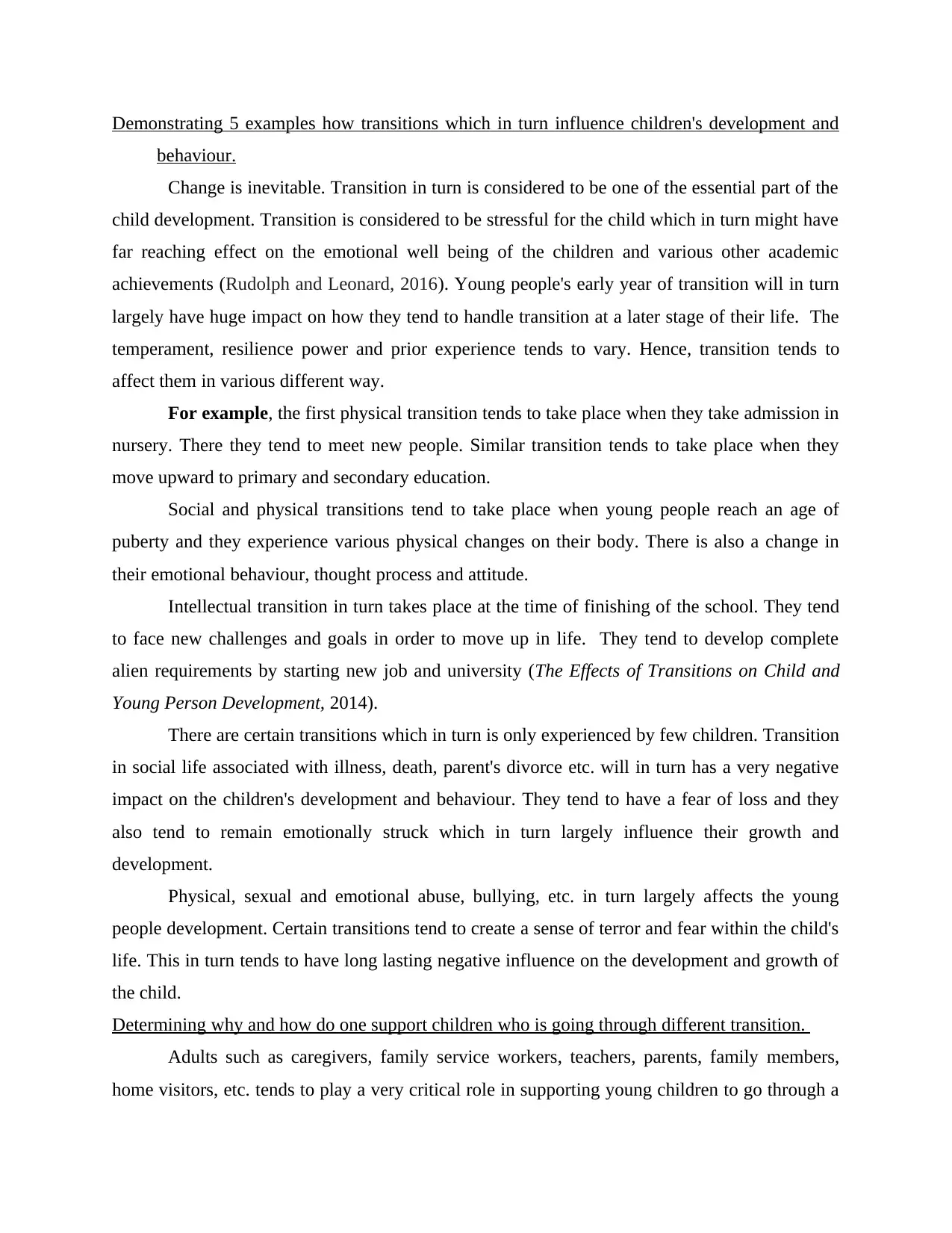
Demonstrating 5 examples how transitions which in turn influence children's development and
behaviour.
Change is inevitable. Transition in turn is considered to be one of the essential part of the
child development. Transition is considered to be stressful for the child which in turn might have
far reaching effect on the emotional well being of the children and various other academic
achievements (Rudolph and Leonard, 2016). Young people's early year of transition will in turn
largely have huge impact on how they tend to handle transition at a later stage of their life. The
temperament, resilience power and prior experience tends to vary. Hence, transition tends to
affect them in various different way.
For example, the first physical transition tends to take place when they take admission in
nursery. There they tend to meet new people. Similar transition tends to take place when they
move upward to primary and secondary education.
Social and physical transitions tend to take place when young people reach an age of
puberty and they experience various physical changes on their body. There is also a change in
their emotional behaviour, thought process and attitude.
Intellectual transition in turn takes place at the time of finishing of the school. They tend
to face new challenges and goals in order to move up in life. They tend to develop complete
alien requirements by starting new job and university (The Effects of Transitions on Child and
Young Person Development, 2014).
There are certain transitions which in turn is only experienced by few children. Transition
in social life associated with illness, death, parent's divorce etc. will in turn has a very negative
impact on the children's development and behaviour. They tend to have a fear of loss and they
also tend to remain emotionally struck which in turn largely influence their growth and
development.
Physical, sexual and emotional abuse, bullying, etc. in turn largely affects the young
people development. Certain transitions tend to create a sense of terror and fear within the child's
life. This in turn tends to have long lasting negative influence on the development and growth of
the child.
Determining why and how do one support children who is going through different transition.
Adults such as caregivers, family service workers, teachers, parents, family members,
home visitors, etc. tends to play a very critical role in supporting young children to go through a
behaviour.
Change is inevitable. Transition in turn is considered to be one of the essential part of the
child development. Transition is considered to be stressful for the child which in turn might have
far reaching effect on the emotional well being of the children and various other academic
achievements (Rudolph and Leonard, 2016). Young people's early year of transition will in turn
largely have huge impact on how they tend to handle transition at a later stage of their life. The
temperament, resilience power and prior experience tends to vary. Hence, transition tends to
affect them in various different way.
For example, the first physical transition tends to take place when they take admission in
nursery. There they tend to meet new people. Similar transition tends to take place when they
move upward to primary and secondary education.
Social and physical transitions tend to take place when young people reach an age of
puberty and they experience various physical changes on their body. There is also a change in
their emotional behaviour, thought process and attitude.
Intellectual transition in turn takes place at the time of finishing of the school. They tend
to face new challenges and goals in order to move up in life. They tend to develop complete
alien requirements by starting new job and university (The Effects of Transitions on Child and
Young Person Development, 2014).
There are certain transitions which in turn is only experienced by few children. Transition
in social life associated with illness, death, parent's divorce etc. will in turn has a very negative
impact on the children's development and behaviour. They tend to have a fear of loss and they
also tend to remain emotionally struck which in turn largely influence their growth and
development.
Physical, sexual and emotional abuse, bullying, etc. in turn largely affects the young
people development. Certain transitions tend to create a sense of terror and fear within the child's
life. This in turn tends to have long lasting negative influence on the development and growth of
the child.
Determining why and how do one support children who is going through different transition.
Adults such as caregivers, family service workers, teachers, parents, family members,
home visitors, etc. tends to play a very critical role in supporting young children to go through a
Paraphrase This Document
Need a fresh take? Get an instant paraphrase of this document with our AI Paraphraser
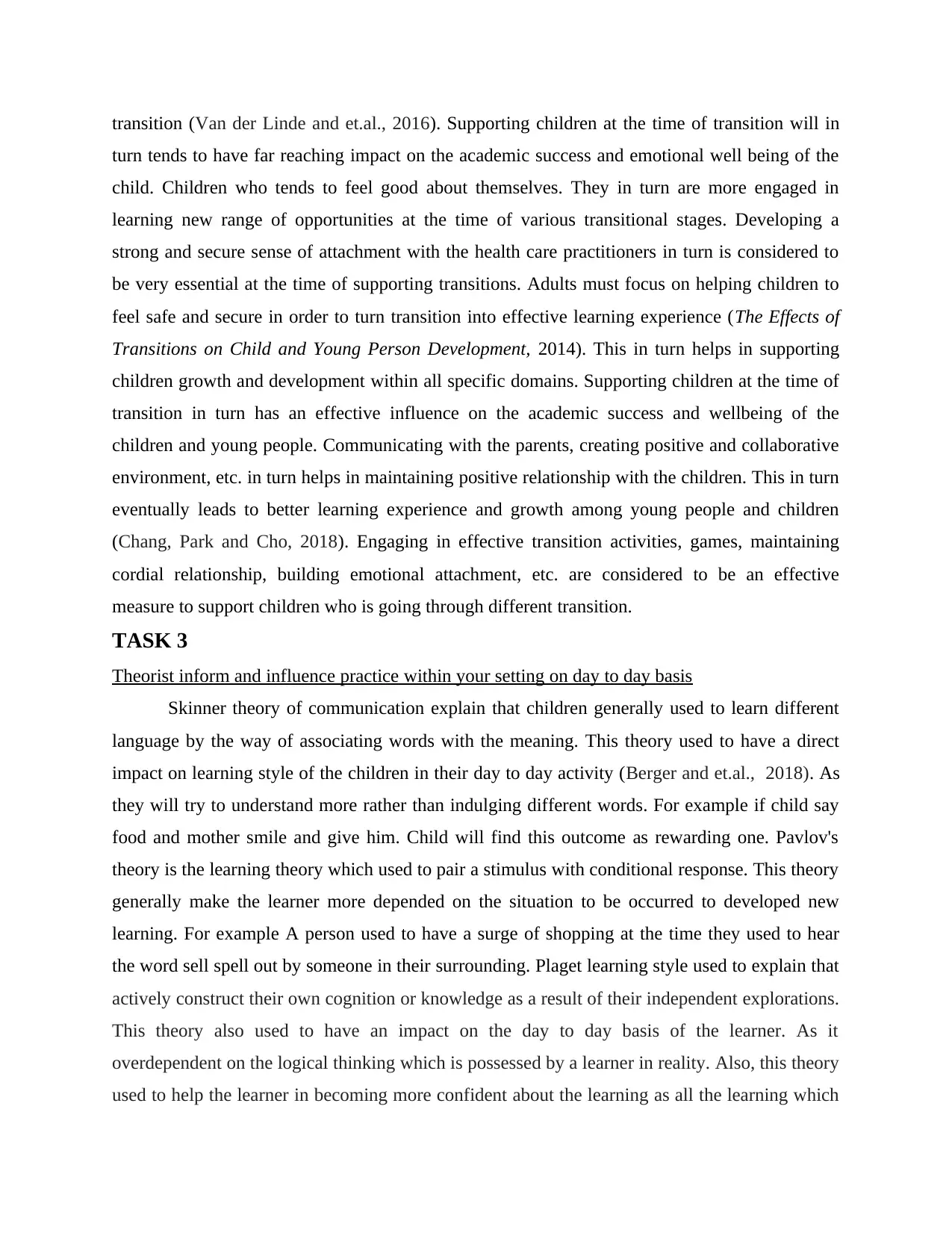
transition (Van der Linde and et.al., 2016). Supporting children at the time of transition will in
turn tends to have far reaching impact on the academic success and emotional well being of the
child. Children who tends to feel good about themselves. They in turn are more engaged in
learning new range of opportunities at the time of various transitional stages. Developing a
strong and secure sense of attachment with the health care practitioners in turn is considered to
be very essential at the time of supporting transitions. Adults must focus on helping children to
feel safe and secure in order to turn transition into effective learning experience (The Effects of
Transitions on Child and Young Person Development, 2014). This in turn helps in supporting
children growth and development within all specific domains. Supporting children at the time of
transition in turn has an effective influence on the academic success and wellbeing of the
children and young people. Communicating with the parents, creating positive and collaborative
environment, etc. in turn helps in maintaining positive relationship with the children. This in turn
eventually leads to better learning experience and growth among young people and children
(Chang, Park and Cho, 2018). Engaging in effective transition activities, games, maintaining
cordial relationship, building emotional attachment, etc. are considered to be an effective
measure to support children who is going through different transition.
TASK 3
Theorist inform and influence practice within your setting on day to day basis
Skinner theory of communication explain that children generally used to learn different
language by the way of associating words with the meaning. This theory used to have a direct
impact on learning style of the children in their day to day activity (Berger and et.al., 2018). As
they will try to understand more rather than indulging different words. For example if child say
food and mother smile and give him. Child will find this outcome as rewarding one. Pavlov's
theory is the learning theory which used to pair a stimulus with conditional response. This theory
generally make the learner more depended on the situation to be occurred to developed new
learning. For example A person used to have a surge of shopping at the time they used to hear
the word sell spell out by someone in their surrounding. Plaget learning style used to explain that
actively construct their own cognition or knowledge as a result of their independent explorations.
This theory also used to have an impact on the day to day basis of the learner. As it
overdependent on the logical thinking which is possessed by a learner in reality. Also, this theory
used to help the learner in becoming more confident about the learning as all the learning which
turn tends to have far reaching impact on the academic success and emotional well being of the
child. Children who tends to feel good about themselves. They in turn are more engaged in
learning new range of opportunities at the time of various transitional stages. Developing a
strong and secure sense of attachment with the health care practitioners in turn is considered to
be very essential at the time of supporting transitions. Adults must focus on helping children to
feel safe and secure in order to turn transition into effective learning experience (The Effects of
Transitions on Child and Young Person Development, 2014). This in turn helps in supporting
children growth and development within all specific domains. Supporting children at the time of
transition in turn has an effective influence on the academic success and wellbeing of the
children and young people. Communicating with the parents, creating positive and collaborative
environment, etc. in turn helps in maintaining positive relationship with the children. This in turn
eventually leads to better learning experience and growth among young people and children
(Chang, Park and Cho, 2018). Engaging in effective transition activities, games, maintaining
cordial relationship, building emotional attachment, etc. are considered to be an effective
measure to support children who is going through different transition.
TASK 3
Theorist inform and influence practice within your setting on day to day basis
Skinner theory of communication explain that children generally used to learn different
language by the way of associating words with the meaning. This theory used to have a direct
impact on learning style of the children in their day to day activity (Berger and et.al., 2018). As
they will try to understand more rather than indulging different words. For example if child say
food and mother smile and give him. Child will find this outcome as rewarding one. Pavlov's
theory is the learning theory which used to pair a stimulus with conditional response. This theory
generally make the learner more depended on the situation to be occurred to developed new
learning. For example A person used to have a surge of shopping at the time they used to hear
the word sell spell out by someone in their surrounding. Plaget learning style used to explain that
actively construct their own cognition or knowledge as a result of their independent explorations.
This theory also used to have an impact on the day to day basis of the learner. As it
overdependent on the logical thinking which is possessed by a learner in reality. Also, this theory
used to help the learner in becoming more confident about the learning as all the learning which
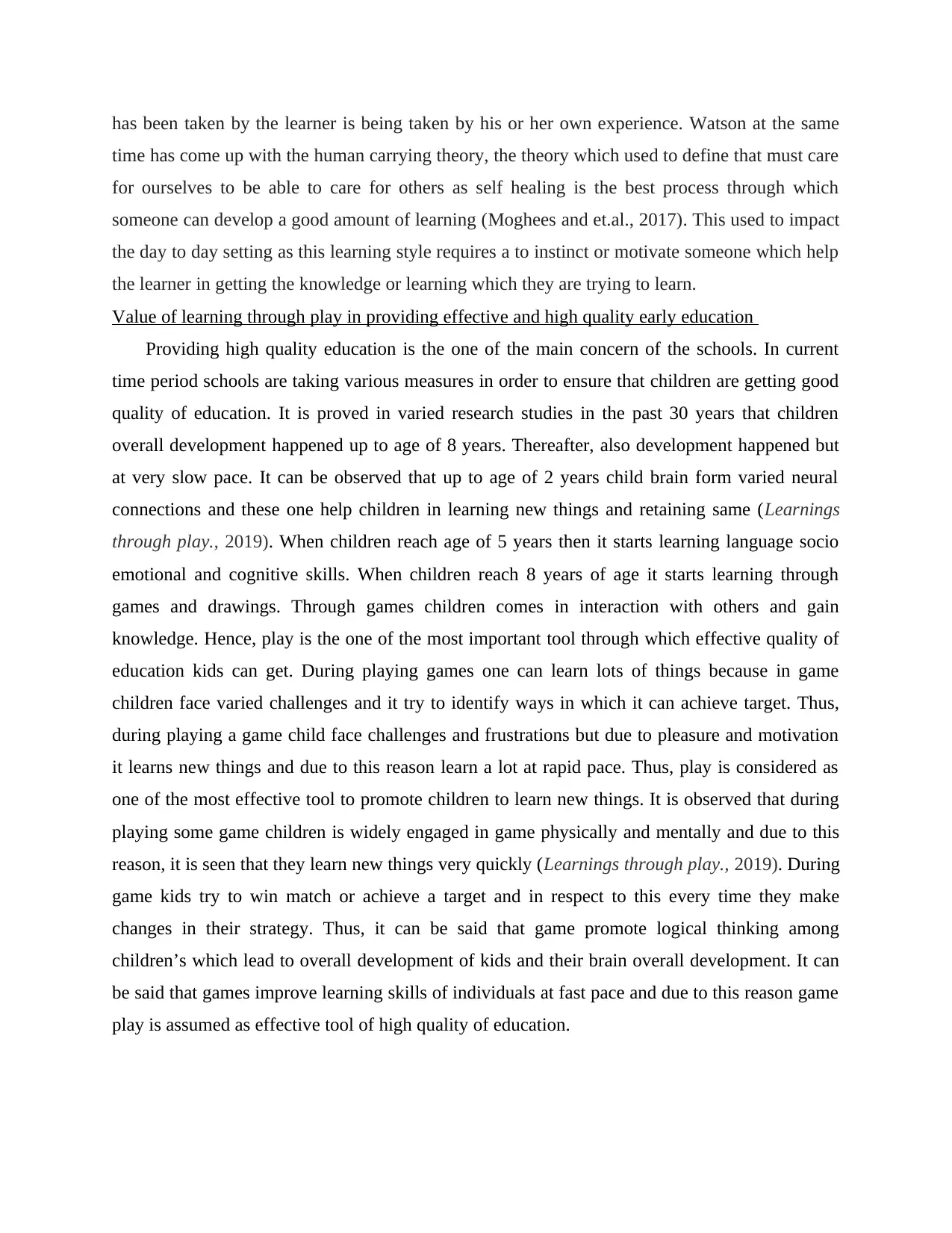
has been taken by the learner is being taken by his or her own experience. Watson at the same
time has come up with the human carrying theory, the theory which used to define that must care
for ourselves to be able to care for others as self healing is the best process through which
someone can develop a good amount of learning (Moghees and et.al., 2017). This used to impact
the day to day setting as this learning style requires a to instinct or motivate someone which help
the learner in getting the knowledge or learning which they are trying to learn.
Value of learning through play in providing effective and high quality early education
Providing high quality education is the one of the main concern of the schools. In current
time period schools are taking various measures in order to ensure that children are getting good
quality of education. It is proved in varied research studies in the past 30 years that children
overall development happened up to age of 8 years. Thereafter, also development happened but
at very slow pace. It can be observed that up to age of 2 years child brain form varied neural
connections and these one help children in learning new things and retaining same (Learnings
through play., 2019). When children reach age of 5 years then it starts learning language socio
emotional and cognitive skills. When children reach 8 years of age it starts learning through
games and drawings. Through games children comes in interaction with others and gain
knowledge. Hence, play is the one of the most important tool through which effective quality of
education kids can get. During playing games one can learn lots of things because in game
children face varied challenges and it try to identify ways in which it can achieve target. Thus,
during playing a game child face challenges and frustrations but due to pleasure and motivation
it learns new things and due to this reason learn a lot at rapid pace. Thus, play is considered as
one of the most effective tool to promote children to learn new things. It is observed that during
playing some game children is widely engaged in game physically and mentally and due to this
reason, it is seen that they learn new things very quickly (Learnings through play., 2019). During
game kids try to win match or achieve a target and in respect to this every time they make
changes in their strategy. Thus, it can be said that game promote logical thinking among
children’s which lead to overall development of kids and their brain overall development. It can
be said that games improve learning skills of individuals at fast pace and due to this reason game
play is assumed as effective tool of high quality of education.
time has come up with the human carrying theory, the theory which used to define that must care
for ourselves to be able to care for others as self healing is the best process through which
someone can develop a good amount of learning (Moghees and et.al., 2017). This used to impact
the day to day setting as this learning style requires a to instinct or motivate someone which help
the learner in getting the knowledge or learning which they are trying to learn.
Value of learning through play in providing effective and high quality early education
Providing high quality education is the one of the main concern of the schools. In current
time period schools are taking various measures in order to ensure that children are getting good
quality of education. It is proved in varied research studies in the past 30 years that children
overall development happened up to age of 8 years. Thereafter, also development happened but
at very slow pace. It can be observed that up to age of 2 years child brain form varied neural
connections and these one help children in learning new things and retaining same (Learnings
through play., 2019). When children reach age of 5 years then it starts learning language socio
emotional and cognitive skills. When children reach 8 years of age it starts learning through
games and drawings. Through games children comes in interaction with others and gain
knowledge. Hence, play is the one of the most important tool through which effective quality of
education kids can get. During playing games one can learn lots of things because in game
children face varied challenges and it try to identify ways in which it can achieve target. Thus,
during playing a game child face challenges and frustrations but due to pleasure and motivation
it learns new things and due to this reason learn a lot at rapid pace. Thus, play is considered as
one of the most effective tool to promote children to learn new things. It is observed that during
playing some game children is widely engaged in game physically and mentally and due to this
reason, it is seen that they learn new things very quickly (Learnings through play., 2019). During
game kids try to win match or achieve a target and in respect to this every time they make
changes in their strategy. Thus, it can be said that game promote logical thinking among
children’s which lead to overall development of kids and their brain overall development. It can
be said that games improve learning skills of individuals at fast pace and due to this reason game
play is assumed as effective tool of high quality of education.
⊘ This is a preview!⊘
Do you want full access?
Subscribe today to unlock all pages.

Trusted by 1+ million students worldwide
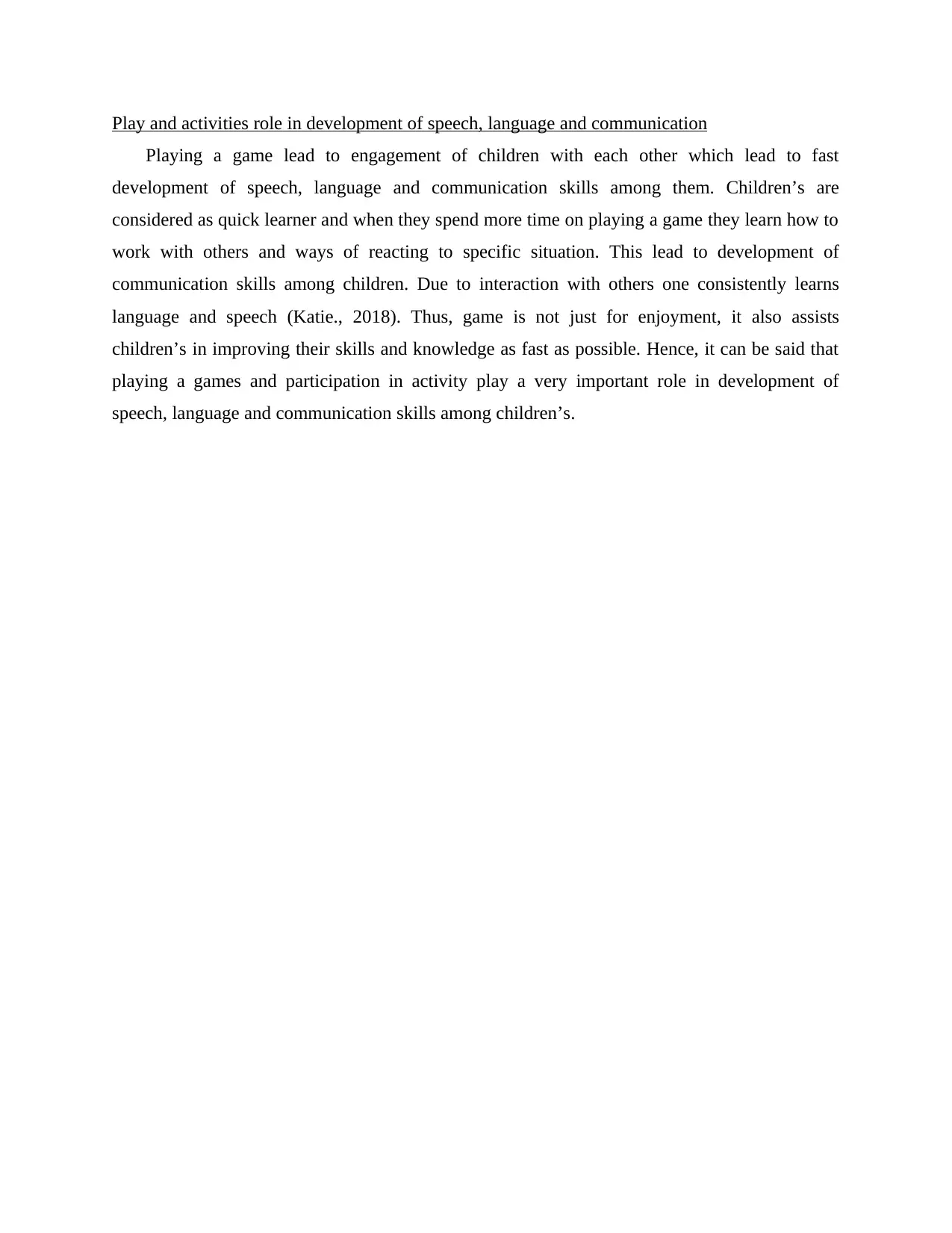
Play and activities role in development of speech, language and communication
Playing a game lead to engagement of children with each other which lead to fast
development of speech, language and communication skills among them. Children’s are
considered as quick learner and when they spend more time on playing a game they learn how to
work with others and ways of reacting to specific situation. This lead to development of
communication skills among children. Due to interaction with others one consistently learns
language and speech (Katie., 2018). Thus, game is not just for enjoyment, it also assists
children’s in improving their skills and knowledge as fast as possible. Hence, it can be said that
playing a games and participation in activity play a very important role in development of
speech, language and communication skills among children’s.
Playing a game lead to engagement of children with each other which lead to fast
development of speech, language and communication skills among them. Children’s are
considered as quick learner and when they spend more time on playing a game they learn how to
work with others and ways of reacting to specific situation. This lead to development of
communication skills among children. Due to interaction with others one consistently learns
language and speech (Katie., 2018). Thus, game is not just for enjoyment, it also assists
children’s in improving their skills and knowledge as fast as possible. Hence, it can be said that
playing a games and participation in activity play a very important role in development of
speech, language and communication skills among children’s.
Paraphrase This Document
Need a fresh take? Get an instant paraphrase of this document with our AI Paraphraser
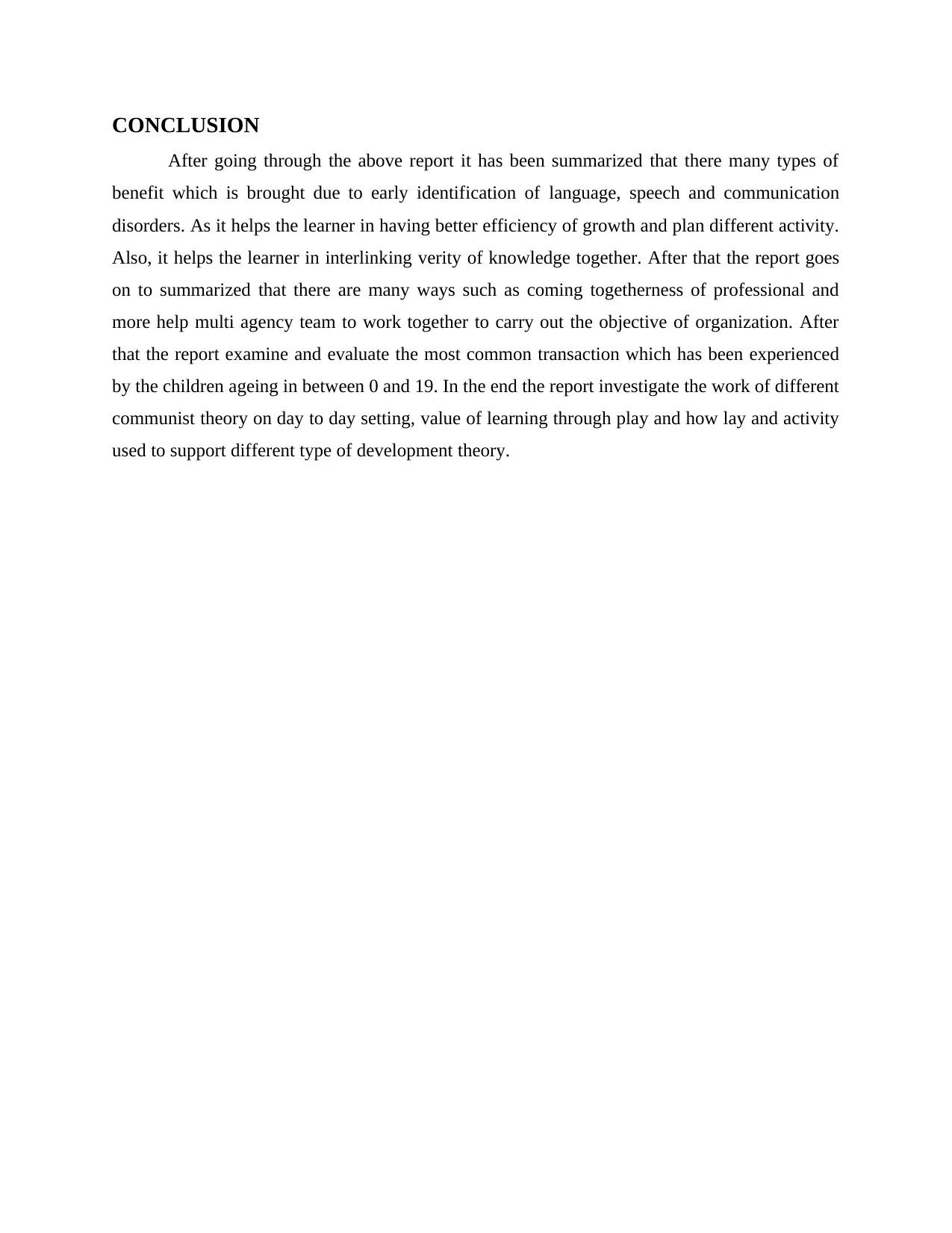
CONCLUSION
After going through the above report it has been summarized that there many types of
benefit which is brought due to early identification of language, speech and communication
disorders. As it helps the learner in having better efficiency of growth and plan different activity.
Also, it helps the learner in interlinking verity of knowledge together. After that the report goes
on to summarized that there are many ways such as coming togetherness of professional and
more help multi agency team to work together to carry out the objective of organization. After
that the report examine and evaluate the most common transaction which has been experienced
by the children ageing in between 0 and 19. In the end the report investigate the work of different
communist theory on day to day setting, value of learning through play and how lay and activity
used to support different type of development theory.
After going through the above report it has been summarized that there many types of
benefit which is brought due to early identification of language, speech and communication
disorders. As it helps the learner in having better efficiency of growth and plan different activity.
Also, it helps the learner in interlinking verity of knowledge together. After that the report goes
on to summarized that there are many ways such as coming togetherness of professional and
more help multi agency team to work together to carry out the objective of organization. After
that the report examine and evaluate the most common transaction which has been experienced
by the children ageing in between 0 and 19. In the end the report investigate the work of different
communist theory on day to day setting, value of learning through play and how lay and activity
used to support different type of development theory.
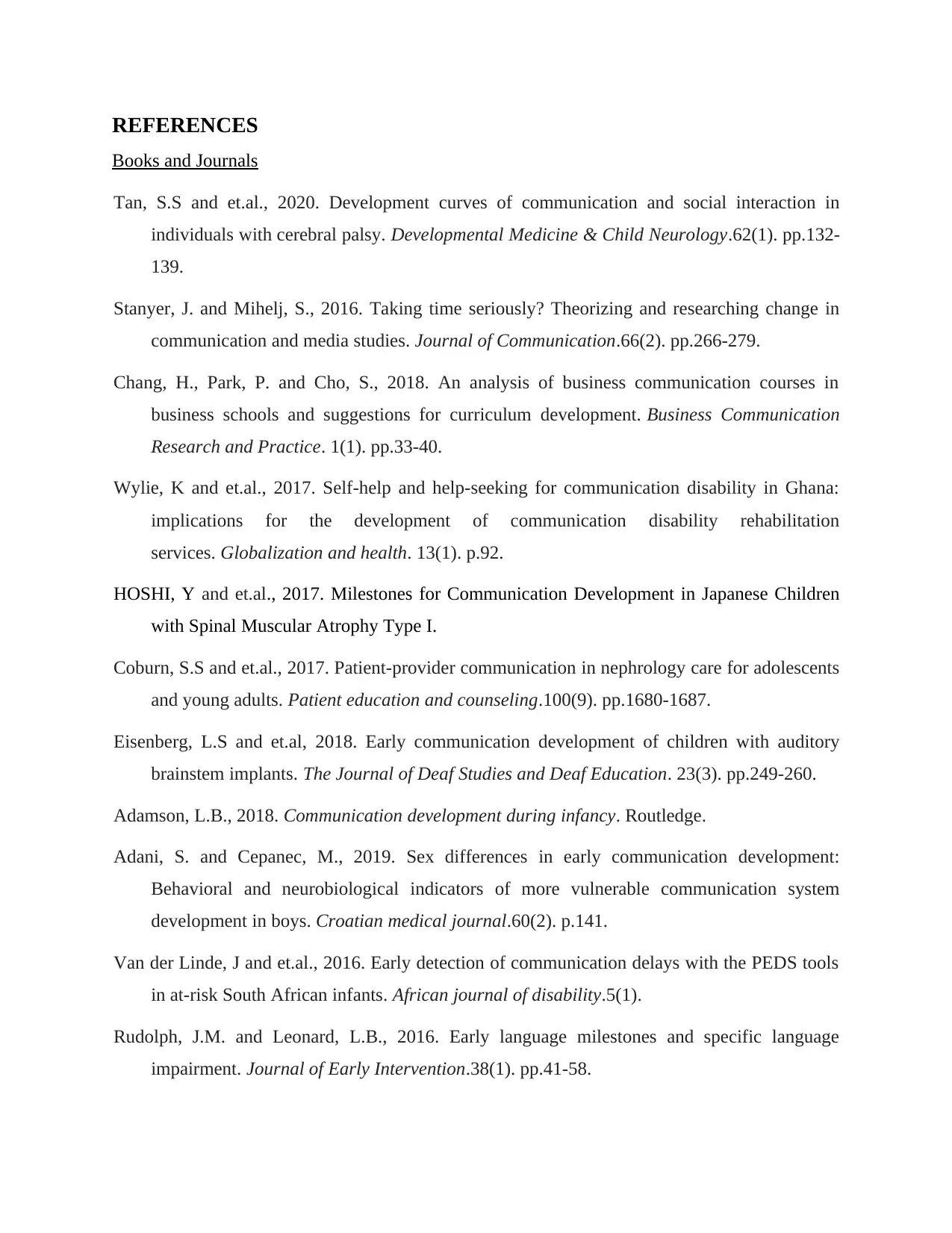
REFERENCES
Books and Journals
Tan, S.S and et.al., 2020. Development curves of communication and social interaction in
individuals with cerebral palsy. Developmental Medicine & Child Neurology.62(1). pp.132-
139.
Stanyer, J. and Mihelj, S., 2016. Taking time seriously? Theorizing and researching change in
communication and media studies. Journal of Communication.66(2). pp.266-279.
Chang, H., Park, P. and Cho, S., 2018. An analysis of business communication courses in
business schools and suggestions for curriculum development. Business Communication
Research and Practice. 1(1). pp.33-40.
Wylie, K and et.al., 2017. Self-help and help-seeking for communication disability in Ghana:
implications for the development of communication disability rehabilitation
services. Globalization and health. 13(1). p.92.
HOSHI, Y and et.al., 2017. Milestones for Communication Development in Japanese Children
with Spinal Muscular Atrophy Type I.
Coburn, S.S and et.al., 2017. Patient-provider communication in nephrology care for adolescents
and young adults. Patient education and counseling.100(9). pp.1680-1687.
Eisenberg, L.S and et.al, 2018. Early communication development of children with auditory
brainstem implants. The Journal of Deaf Studies and Deaf Education. 23(3). pp.249-260.
Adamson, L.B., 2018. Communication development during infancy. Routledge.
Adani, S. and Cepanec, M., 2019. Sex differences in early communication development:
Behavioral and neurobiological indicators of more vulnerable communication system
development in boys. Croatian medical journal.60(2). p.141.
Van der Linde, J and et.al., 2016. Early detection of communication delays with the PEDS tools
in at-risk South African infants. African journal of disability.5(1).
Rudolph, J.M. and Leonard, L.B., 2016. Early language milestones and specific language
impairment. Journal of Early Intervention.38(1). pp.41-58.
Books and Journals
Tan, S.S and et.al., 2020. Development curves of communication and social interaction in
individuals with cerebral palsy. Developmental Medicine & Child Neurology.62(1). pp.132-
139.
Stanyer, J. and Mihelj, S., 2016. Taking time seriously? Theorizing and researching change in
communication and media studies. Journal of Communication.66(2). pp.266-279.
Chang, H., Park, P. and Cho, S., 2018. An analysis of business communication courses in
business schools and suggestions for curriculum development. Business Communication
Research and Practice. 1(1). pp.33-40.
Wylie, K and et.al., 2017. Self-help and help-seeking for communication disability in Ghana:
implications for the development of communication disability rehabilitation
services. Globalization and health. 13(1). p.92.
HOSHI, Y and et.al., 2017. Milestones for Communication Development in Japanese Children
with Spinal Muscular Atrophy Type I.
Coburn, S.S and et.al., 2017. Patient-provider communication in nephrology care for adolescents
and young adults. Patient education and counseling.100(9). pp.1680-1687.
Eisenberg, L.S and et.al, 2018. Early communication development of children with auditory
brainstem implants. The Journal of Deaf Studies and Deaf Education. 23(3). pp.249-260.
Adamson, L.B., 2018. Communication development during infancy. Routledge.
Adani, S. and Cepanec, M., 2019. Sex differences in early communication development:
Behavioral and neurobiological indicators of more vulnerable communication system
development in boys. Croatian medical journal.60(2). p.141.
Van der Linde, J and et.al., 2016. Early detection of communication delays with the PEDS tools
in at-risk South African infants. African journal of disability.5(1).
Rudolph, J.M. and Leonard, L.B., 2016. Early language milestones and specific language
impairment. Journal of Early Intervention.38(1). pp.41-58.
⊘ This is a preview!⊘
Do you want full access?
Subscribe today to unlock all pages.

Trusted by 1+ million students worldwide
1 out of 13
Related Documents
Your All-in-One AI-Powered Toolkit for Academic Success.
+13062052269
info@desklib.com
Available 24*7 on WhatsApp / Email
![[object Object]](/_next/static/media/star-bottom.7253800d.svg)
Unlock your academic potential
Copyright © 2020–2025 A2Z Services. All Rights Reserved. Developed and managed by ZUCOL.





